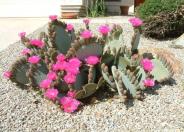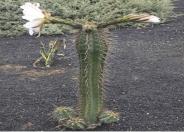
Common name:Horsetail
Botanical name:Equisetum hyemale
This reed-like plant has dark green, jointed stems that reach 3'-4' tall but will spread. It should receive sun to part shade with regular summer watering. The reed grass can be extremely invasive and is best when used in pots or when confined by a barri

Common name:Beavertail Prickly Pear Cactus
Botanical name:Opuntia basilaris
This cactus grows to 2' tall and 4' wide. Pads, which resemble Beaver tails, are blue-grey, sometimes with a bit of purple. New pads form on lower areas of the plant.. Flowers are intensely rose purple from spring to early summer. This plant prefers full sun with fast draining soil. It is drought tolerant once it's established.

Common name:Mescal Agave
Botanical name:Agave parryi
A tight medium sized rosette sometimes solitary, sometimes with offsets. The leaves can vary much in size and color. The flower spike is up to 20' in height with bright yellow and red buds in mid summer. Native in central and southern Arizona into New Mexico at 1000-8000'. One of the most cold hardy. Full sun or part shade but needs good drainage. Heavily toothed rosettes.

Common name:Achuma Cactus; Bolivian Torch
Botanical name:Echinopsis lageniformis
Bolivian Torch Cactus has four to eight wide set ribs with spines set 1-2 inches apart in clusters. The main body can be a variety of hues from green to a bluish color. Their spines can be a light golden color to a deeper brown. The spines grow in groups of four from the areoles of the cactus. With two to four inch long spines, Bolivian Torch Cactus is a plant you want to take seriously. This cactus grows straight like a pole but tends to be shorter than many other cacti in its region. Some might even call it unimpressive. Contrary to this belief, Bolivian Torch Cactus is often highly sought out by ornamental cactus collectors. The Scientific name for Bolivian Torch Cactus is Echinopsis lageniformis; it was previously Trichocereus bridgesii. More common names for Bolivian Torch Cactus include Bolivian Torch and Cactus of the Four Winds. Because it is highly adaptive and drought resistant, Bolivian Torch Cactus is the easiest mescaline cactus to care for. They require very low humidity and only require intense care when it comes to fertilization and repotting. Bolivian Torch Cactus likes to be in the sun; it requires full light 6-8 hours per day. If the sun becomes too blazing in the summertime, your Bolivian Torch Cactus will need to be shaded and given a break to avoid being scorched. Gravely, well draining soil that is fertile is best for Bolivian Torch Cactus. You can use a mix of two parts vermiculite, one part peat moss, and one part sand. A small amount of organic potting soil could also be added to the mixtures. The best pH for Bolivian Torch Cactus is between six and seven. Only water your Bolivian Torch Cactus when the soil is completely dry, but not so dry that it starts to harden into a puck. When watering, allow the excess water to completely drain out of the holes in the bottom of the pot. Make sure to empty any tray or dish under the container to avoid excess moisture. Bolivian torch cactus is drought resistant and stores water inside itself to survive the high temperatures and dry environment it naturally grows in. The best temperature for Bolivian Torch Cactus is between 68F and 95F. If temperatures reach below 50F or above 95F, it can stunt your cactus’ growth. Your Bolivian Torch Cactus will move into dormancy at these temperatures. In the spring, summer and fall, fertilize your Bolivian Torch Cactus once a month with a liquid fertilizer. A small amount of fertilizer such as eggshell powder or vermicompost can be added to the soil during repotting in early spring or fall. Bolivian Torch Cactus has a beautiful white blossom that is 8 inches long and 4 inches in diameter. The bloom comes out of the top of the cactus head. Once the flower has been pollinated, it will start to grow into a fruit. The fruit of the Bolivian Torch Cactus is edible. The fruit is ready to be picked when it turns red.
Designer: UC Berkeley
Photographer: Vicki Anderson
Practice grass-cycling by leaving short grass clippings on lawns after mowing, so that nutrients and organic matter are returned to the soil.
Develop healthy soil for plants that are vigorous and naturally pest-resistant.